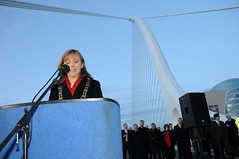Fellow Dubliners, Fellow City Councillors, Ministers, Members of the Oireachtas, City Manager, Members of the Beckett family and other Distinguished Guests, you are all very welcome here today to the Opening of the Samuel Beckett Bridge.
This wonderful feat of architecture and engineering was officially named the Samuel Beckett Bridge by resolution of Dublin City Council in April 2006, to formally mark the centenary of the Nobel Laureate’s birth. Fittingly, this month marks the 20th anniversary of his death.
Bridges have held a special place in the hearts of Dubliners for many centuries. Even our City’s name –Baile Atha Cliath – the town of the ford of the hurdles derived from an ancient crossing over the river Liffey. In fact, the City grew around the first river crossing at Church Street over a thousand years ago. Since the beginning of the new millennium, Dublin has seen the opening of 4 new landmark bridges with Samuel Beckett is the latest of these to be added to our impressive inventory of Liffey Bridges, leaving a lasting legacy for future generations to enjoy.
It goes almost without saying that Dublin is first and foremost a literary city. Dubliners are justifiably proud of their writers - and in the city’s recent submission for designation as a UNESCO City of Literature, under the heading ‘Honouring Literature’, much play has been made of Dublin’s cultural profile – with its monuments and its many streets named after our illustrious authors. In dedicating this architectural and engineering icon to one of the 20th century’s literary giants, Samuel Beckett, Dublin is maintaining a tradition of publicly honouring some of its greatest writers in a very tangible and practical way.
The Samuel Beckett Bridge is the second bridge to be designed by Dr Calatrava, the other being the James Joyce Bridge in 2003, on the west side of the City at Blackhall Place. I’m sure that both James Joyce and Samuel Beckett would indeed have been very gratified to have two enduring icons indelibly etched on Dublin’s landscape in their memory, especially since both were exclusively designed by such an internationally acclaimed artist, architect and engineer.
It gives me great pleasure to welcome Micael (pronounced ‘meek-hile’) Calatrava, Dr. Calatrava’s son, who is representing his father here today, bearing witness to the fruits of the challenge that designing such a signature Bridge presented to the great Designer. I know that Dr. Calatrava has gone on record as saying that while working on the James Joyce Bridge, he developed a deep affinity for the people of Dublin, and he wanted his next bridge to celebrate that connection. I also know it was his sincere hope that the Samuel Beckett Bridge would serve as a monument to Dublin, honouring its past, present and future.
To me bridges are among the most powerful and important symbols in human society – symbols of connection, of cooperation and of harmony. It is the construction of bridges, metaphorically and literally, that marks our progress. The Docklands area has undergone immense regeneration and change in the past 12 years, thanks to a very strong and active sense of community and engagement, north and south of the Liffey, and the Samuel Beckett Bridge pays fitting homage to the efforts of all those that have made a contribution.
As I stand on this beautiful structure, I take great pride at the inspiration behind Dr. Calatrava’s design - the image of the harp on the back of an Irish coin, reflecting the shape of our national emblem. The challenges of its construction were solved by practical means, just as its purpose, here, is solidly practical to provide easy access to and from Guild Street on Dublin’s northside with Sir John Rogerson’s Quay on the southside. But practical does not necessarily have to fall victim to the banal, dull or routine, as this icon of unmistakable modernity and unique character amply attests.
Finally, the Beckett Bridge is now a central part of our transport infrastructure and will, no doubt, have a huge role to play on easing the impact of traffic in the City centre, by improving traffic circulation, and in facilitating future modes of public transport and light rail. It will also promote and enhance the pedestrian environment in the City centre. This is the second great transport project to open this week in the East Inner City Area, of course the other being the opening of the extension of the Luas Red Line on Tuesday from Busáras to the O2. Now Dubliners, Commuters and Visitors alike, will be able to easily traverse the City from east to west and back again. I would like to thank all the staff and joint venture partners Graham-Hollandia who together with the entire Project Team, have brought Dr. Calatrava’s wonderful design to life.
It is a huge privilege for me as Lord Mayor to open Beckett Bridge.
End.

No comments:
Post a Comment